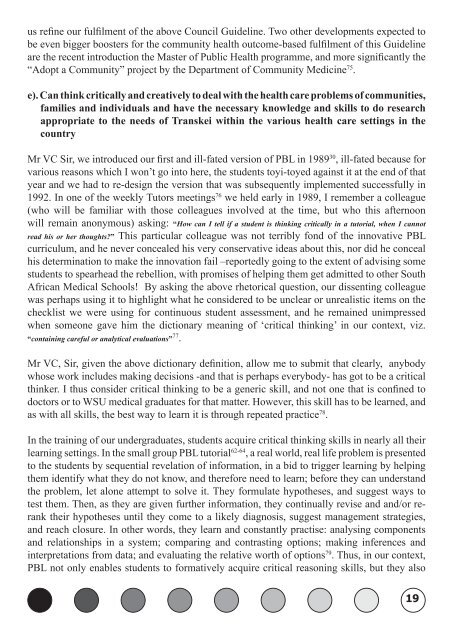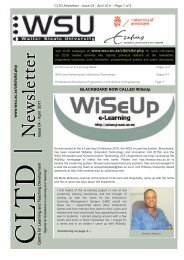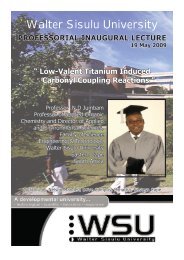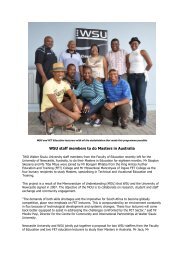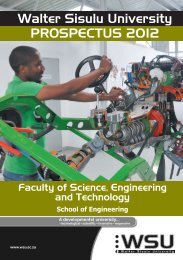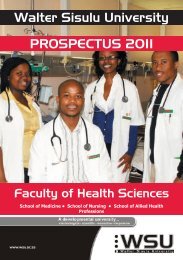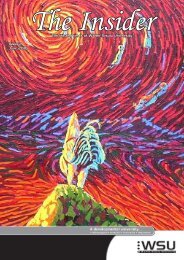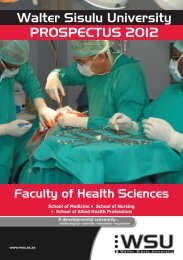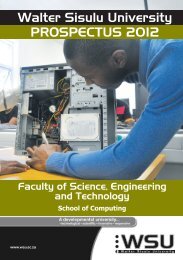25 years of training doctors at WSU: how - Walter Sisulu University
25 years of training doctors at WSU: how - Walter Sisulu University
25 years of training doctors at WSU: how - Walter Sisulu University
Create successful ePaper yourself
Turn your PDF publications into a flip-book with our unique Google optimized e-Paper software.
us refine our fulfilment <strong>of</strong> the above Council Guideline. Two other developments expected to<br />
be even bigger boosters for the community health outcome-based fulfilment <strong>of</strong> this Guideline<br />
are the recent introduction the Master <strong>of</strong> Public Health programme, and more significantly the<br />
“Adopt a Community” project by the Department <strong>of</strong> Community Medicine 75 .<br />
e). Can think critically and cre<strong>at</strong>ively to deal with the health care problems <strong>of</strong> communities,<br />
families and individuals and have the necessary knowledge and skills to do research<br />
appropri<strong>at</strong>e to the needs <strong>of</strong> Transkei within the various health care settings in the<br />
country<br />
Mr VC Sir, we introduced our first and ill-f<strong>at</strong>ed version <strong>of</strong> PBL in 1989 30 , ill-f<strong>at</strong>ed because for<br />
various reasons which I won’t go into here, the students toyi-toyed against it <strong>at</strong> the end <strong>of</strong> th<strong>at</strong><br />
year and we had to re-design the version th<strong>at</strong> was subsequently implemented successfully in<br />
1992. In one <strong>of</strong> the weekly Tutors meetings 76 we held early in 1989, I remember a colleague<br />
(who will be familiar with those colleagues involved <strong>at</strong> the time, but who this afternoon<br />
will remain anonymous) asking: “How can I tell if a student is thinking critically in a tutorial, when I cannot<br />
read his or her thoughts?” This particular colleague was not terribly fond <strong>of</strong> the innov<strong>at</strong>ive PBL<br />
curriculum, and he never concealed his very conserv<strong>at</strong>ive ideas about this, nor did he conceal<br />
his determin<strong>at</strong>ion to make the innov<strong>at</strong>ion fail –reportedly going to the extent <strong>of</strong> advising some<br />
students to spearhead the rebellion, with promises <strong>of</strong> helping them get admitted to other South<br />
African Medical Schools! By asking the above rhetorical question, our dissenting colleague<br />
was perhaps using it to highlight wh<strong>at</strong> he considered to be unclear or unrealistic items on the<br />
checklist we were using for continuous student assessment, and he remained unimpressed<br />
when someone gave him the dictionary meaning <strong>of</strong> ‘critical thinking’ in our context, viz.<br />
“containing careful or analytical evalu<strong>at</strong>ions” 77 .<br />
Mr VC, Sir, given the above dictionary definition, allow me to submit th<strong>at</strong> clearly, anybody<br />
whose work includes making decisions -and th<strong>at</strong> is perhaps everybody- has got to be a critical<br />
thinker. I thus consider critical thinking to be a generic skill, and not one th<strong>at</strong> is confined to<br />
<strong>doctors</strong> or to <strong>WSU</strong> medical gradu<strong>at</strong>es for th<strong>at</strong> m<strong>at</strong>ter. However, this skill has to be learned, and<br />
as with all skills, the best way to learn it is through repe<strong>at</strong>ed practice 78 .<br />
In the <strong>training</strong> <strong>of</strong> our undergradu<strong>at</strong>es, students acquire critical thinking skills in nearly all their<br />
learning settings. In the small group PBL tutorial 62-64 , a real world, real life problem is presented<br />
to the students by sequential revel<strong>at</strong>ion <strong>of</strong> inform<strong>at</strong>ion, in a bid to trigger learning by helping<br />
them identify wh<strong>at</strong> they do not know, and therefore need to learn; before they can understand<br />
the problem, let alone <strong>at</strong>tempt to solve it. They formul<strong>at</strong>e hypotheses, and suggest ways to<br />
test them. Then, as they are given further inform<strong>at</strong>ion, they continually revise and and/or rerank<br />
their hypotheses until they come to a likely diagnosis, suggest management str<strong>at</strong>egies,<br />
and reach closure. In other words, they learn and constantly practise: analysing components<br />
and rel<strong>at</strong>ionships in a system; comparing and contrasting options; making inferences and<br />
interpret<strong>at</strong>ions from d<strong>at</strong>a; and evalu<strong>at</strong>ing the rel<strong>at</strong>ive worth <strong>of</strong> options 79 . Thus, in our context,<br />
PBL not only enables students to form<strong>at</strong>ively acquire critical reasoning skills, but they also<br />
19


